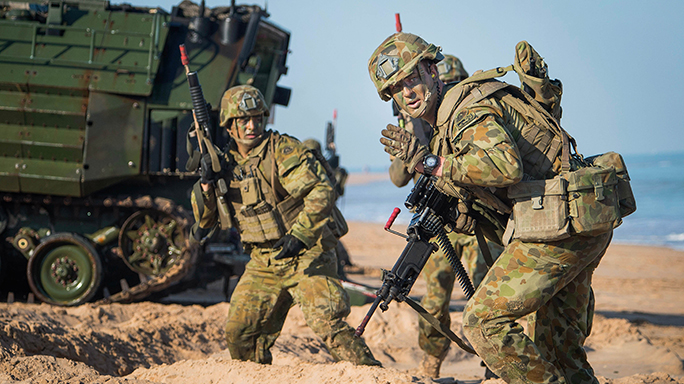The following is a release from the U.S. Marine Corps:
U.S. and Australian forces stormed the beaches of Fog Bay July 11, executing joint amphibious operations, the largest and most complex joint amphibious training of its kind, as part of Talisman Sabre 2015.
- RELATED STORY: US Army Paratroopers Drop Into Talisman Sabre 15
To kick off the amphibious landing, a line of assault amphibious vehicles crashed ashore, releasing hundreds of joint forces to survey and secure the beach, and prepare the area for the landing of vehicles, cargo and personnel that would follow.
Advertisement — Continue Reading Below
Participating assets included U.S. Navy ships and aircraft as part of an offshore amphibious readiness group, forces from the 31st Marine Expeditionary Unit and 2nd Brigade, Royal Australian Regiment soldiers.
U.S. Navy Equipment Operator 2nd Class Rafael Ruiz-Santos, the senior ramp marshal for the beach landing operation, and his team ensured the beach was ready to receive Landing Craft Air Cushion vehicles.
“My team prepped and secured the beach as we were preparing for the landing of our LCACs,” Ruiz-Santos said. “For this operation we have two LCACs that will be transporting personnel and equipment from the [USS Bonhomme Richard] to the beach, and back to the ship at the conclusion of the operation.”
Advertisement — Continue Reading Below
The Marines and Australian soldiers made their way off the beach and into the tree line and worked their way to objective points and eventually combining with the 3rd Marine Expeditionary Brigade.
U.S. Marine Cpl. Jose Arciniega and other 31st MEU members staged on the beach and set up 60mm lightweight mortar mount sites to provide offensive cover for the incoming forces. Arciniega was part of the first wave of Marines to storm the beach.
“I think the landing went smooth,” Arciniega said. “Right now we’re waiting for the LCAC to land, and then we’re going to push up the beach to our objective inland at the airfield.”
Advertisement — Continue Reading Below
Overhead, AV-8B Harriers from USS Bonhomme Richard (LHD 6) provided close air support for advancing ground teams. Other aviation support aircraft included MV-22 Ospreys, CH-53 Chinooks and AH-1 Cobras.
Royal Australian Navy Vice Adm. David Johnston, Chief of Joint Operations Australian Defence Force and Australian Joint Lead for Talisman Sabre 2015, observed the beach landing and said joint training is critical to conducting real-world operations around the world.
“What we get from Talisman Sabre is a highly complex training environment that includes field activities spread throughout the country, and is complemented by a command post activity where our senior staffs work through detail planning, looking at complex scenarios and how we would work with a range of international and intergovernmental partners in order to achieve our objectives,” Johnston said.
Advertisement — Continue Reading Below
U.S. Marine Lt. Gen. John Wissler, 3rd Marine Expeditionary Force commander, said this exercise gives all militaries involved the ability to “execute every one of our capabilities.”
“This is a tremendous opportunity for us,” Wissler said. “The friendships, partnerships and relationships that we build here will be very helpful no matter where we need each other in the world. This integrated training and our ability to train together … will prove very valuable in proving that we can interoperate and coordinate with our partners from Australia.”
Talisman Sabre 2015 is the largest military exercise ever in Australia, and is being conducted in multiple locations both here and in the U.S. The exercise provides all participants the opportunity to conduct operations in a combined, joint and interagency environment.
Advertisement — Continue Reading Below
























